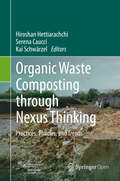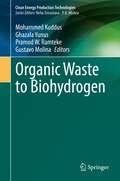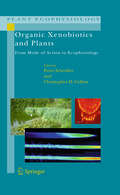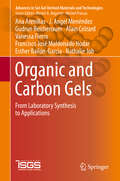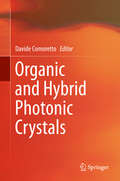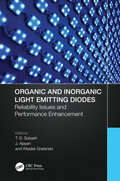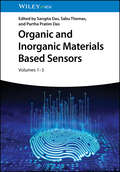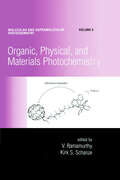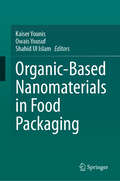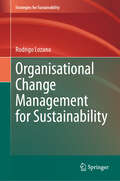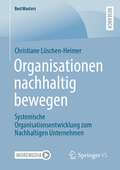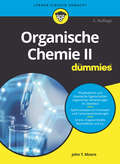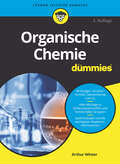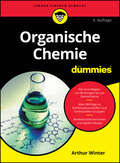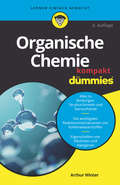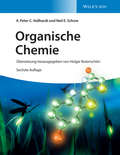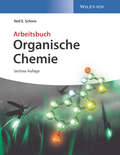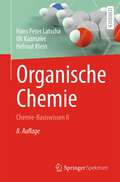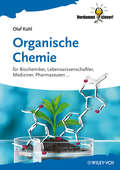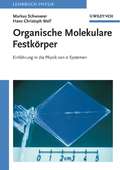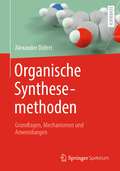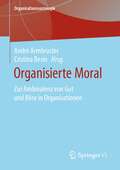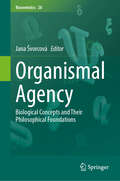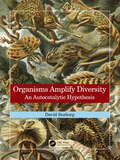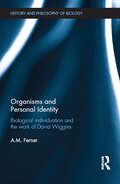- Table View
- List View
Organic Waste Composting through Nexus Thinking: Practices, Policies, and Trends
by Hiroshan Hettiarachchi Kai Schwärzel Serena CaucciOrganic waste composting is another excellent example to demonstrate the power and the benefits of nexus thinking. Even though organic waste composting itself is not a new topic, those who want to start a new project or align an ongoing project with nexus thinking, find it difficult to gather the necessary information. With nine case studies from four continents, this book aims to fill above gap in literature. While current literature on composting is often found to be limited to either soil/agriculture sector or waste management sector, this book presents a combined point of view. This open access book starts with an introductory chapter that describes the need to bring the waste management aspects and soil nutrient management aspects of compost production into one integrated theme. The relevance of nexus thinking and the Sustainable Development Goals (SDGs) are also presented in this introduction. The first three chapters after the introduction covers composting from the solid waste management and its policy aspects, taking examples from three developing countries. The next three examples are mostly about the benefits composting can provide to the soil and agriculture. These examples are also from three developing countries, but with a mixture of urban as well as rural settings. Last three chapters present more insight into the latest developments taking examples from Europe, as well as new methods adapted from the traditional styles from Africa.
Organic Waste to Biohydrogen (Clean Energy Production Technologies)
by Gustavo Molina Mohammed Kuddus Pramod W. Ramteke Ghazala YunusThis book provides an updated knowledge on the biohydrogen production from industrial and municipal organic waste materials. Microbes are increasingly being included in the hydrogen based biofuel production and this book covers the processes and protocols for biohydrogen production. There is an urgent need of alternative energy research to fulfill the global energy demand. Biohydrogen is a promising source of sustainable and clean energy as it harnessed by biological means. Biohydrogen may be produced by utilizing different waste materials as a substrate, and by optimization of various parameters of bioreactors such as temperature, pH, partial pressure etc. The waste materials used in hydrogen production are categorized as agricultural waste, municipal waste, industrial waste, and other hazardous wastes. Biohydrogen production from wastes materials opened a new opportunity for the widespread use of everlasting renewable energy source. This book is useful for professional scientists, academicians, biotechnologist and environmentalist along with research scholars in various biotechnology and bioenergy industries by addressing the latest research going on in the field of renewal bioenergy production from waste and their global impact on the environment.
Organic Xenobiotics and Plants
by Christopher D. Collins Peter SchröderNatural and agro-ecosystems are frequently exposed to natural or synthetic substances, which, while they have no direct nutritional value or significance in metabolism, may negatively affect plant functioning. These, xenobiotics, may originate from both natural (fires, volcano eruptions, soil or rock erosion, biodegradation) and anthropogenic (air and soil pollution, herbicides) sources. And, while affected plants have only a limited number of possibilities for avoiding accumulation of these compounds, they do exhibit several enzymatic reactions for detoxification including oxidation, reduction, hydrolysis and conjugation reactions. In agro-ecosystems in particular these mechanisms have great significance in relation to herbicide detoxification and tolerance. In this volume an international group of experts present an overview of the nature and distribution of organic xenobiotics, including their uptake, effects on plant functioning and detoxification mechanisms. The particular significance of glutathione S-transferases in bio-indication and bio-monitoring, and in the detoxification of volatile organic air pollutants and herbicides is evaluated, and their potential significance in phytoremediation and bioaccumulation will be discussed. This volume will be of interest to a wide audience, from graduate students to senior researchers in a wide range of disciplines including plant ecology, plant biochemistry, agriculture and environmental management. It will also be of practical interest to environmentalists, policy makers and resource managers.
Organic and Carbon Gels: From Laboratory Synthesis to Applications (Advances in Sol-Gel Derived Materials and Technologies)
by Ana Arenillas J. Angel Menéndez Gudrun Reichenauer Alain Celzard Vanessa Fierro Francisco José Maldonado Hodar Esther Bailόn-Garcia Nathalie JobThis expert volume provides specialized coverage of the current state of the art in carbon gels. Carbon gels represent a promising class of materials with high added value applications and many assets, like the ability to accurately tailor their structure, porosity, and surface composition and easily dope them with numerous species. The ability to obtain them in custom shapes, such as powder, beads, monoliths, or impregnated scaffolds opens the way towards numerous applications, including catalysis, adsorption, and electrochemical energy storage, among others. Nevertheless, it remains a crucial question as to which design synthesis and manufacturing processes are viable from an economic and environmental point of view. The book represents the perspectives of renowned specialists in the field, specially invited to conduct a one-day workshop devoted to carbon gels as part of the 19th International Sol-Gel Conference, SOL-GEL 2017, held on September 3rd, 2017 in Liège, Belgium.Addressing properties and synthesis through applications and industry outlook, this book represents essential reading for advanced graduate students through practicing researchers interested in these exciting materials.
Organic and Hybrid Photonic Crystals
by Davide ComorettoThis book provides a multidisciplinary perspective (ranging from chemistry to physics and biology) of the current research and applications of organic and hybrid photonic crystals. The authors detail the chemical and physical tools used to develop organic photonic crystals, explain methods for engineering new nano-structures, and propose novel physical phenomena or technological applications based on such materials. Organic and Hybrid Photonic Crystal lasers, sensors, photovoltaic devices and stimuli responsive devices are discussed.
Organic and Inorganic Light Emitting Diodes: Reliability Issues and Performance Enhancement
by Wladek Grabinski T. D Subash J AjayanThis book covers a comprehensive range of topics on the physical mechanisms of LEDs (light emitting diodes), scattering effects, challenges in fabrication and efficient enhancement techniques in organic and inorganic LEDs. It deals with various reliability issues in organic/inorganic LEDs like trapping and scattering effects, packaging failures, efficiency droops, irradiation effects, thermal degradation mechanisms, and thermal degradation processes. Features: Provides insights into the improvement of performance and reliability of LEDs Highlights the optical power improvement mechanisms in LEDs Covers the challenges in fabrication and packaging of LEDs Discusses pertinent failures and degradation mechanisms Includes droop minimization techniques This book is aimed at researchers and graduate students in LEDs, illumination engineering, optoelectronics, and polymer/organic materials.
Organic and Inorganic Materials Based Sensors, 3 Volumes
by Sabu Thomas Partha Pratim Das Sangita DasOrganic and Inorganic Materials Based Sensors A three-volume comprehensive overview of the development and applications of various novel potent molecular sensor frameworks In Organic and Inorganic Materials Based Sensors (3 Volume Set), a team of distinguished researchers delivers an interdisciplinary presentation of the engineering of high-performance biopolymer-based bio-nanocomposites, as well as strategies for the use of various molecules in the detection of environmentally important guest analytes. This three-volume book explores the most relevant technological developments in nanomaterials sensors and offers a broad and comprehensive overview of cutting-edge research on advanced materials in the fast-moving sensors industry. The authors explain the science behind nanomaterials for environmental remediation as well as the components and ingredients of the relevant materials. Readers will also find: Thorough introductions to sensory devices, polymer-based nano-biomaterials, and opto-electrochemical devices Comprehensive explorations of metal–organic frameworks, organic sensors, and organic–inorganic composite semiconductor sensors Practical discussions of vapochromic and vapoluminescent sensors Fulsome treatments of sensor ecosystems for health self-monitoring, including discussions of diabetes management Perfect for materials scientists, mechanical engineers, and analytical chemists, Organic and Inorganic Materials Based Sensors will also benefit inorganic and organic chemists, robotics engineers, and professionals working in the sensor industry.
Organic, Physical, and Materials Photochemistry
by Kirk S. SchanzeThis text examines organic, physical and materials photochemistry. It reports the first example of a TiO2 sensitization with a fullerene-based donor-acceptor dyad, and covers halophenols, diflusinal photochemistry, hydroxystyrenes, acetylenes, and other related compounds. The volume also investigates whether c,d-alkenes influence the efficiency and
Organic-Based Nanomaterials in Food Packaging
by Shahid Ul Islam Kaiser Younis Owais YousufThe use of nanomaterials in food packaging is a rapidly advancing area with massive potential for increasing shelf life and improving the safety of food products. Up to this point there has not been a suitable reference work covering the basic modules of organic-based nanomaterials in food packaging. This work documents organic nanomaterials and their synthesis; Characterization, composition and structure of organic nanomaterials; Mechanical properties of organic nanomaterials; Cellulose, Starch, Chitosan, protein and conjugated organic nanomaterials for food packaging plus nano emulsions for edible coating and the overall safety and regulatory aspects of organic nanomaterials. Organic-Based Nanomaterials in Food Packaging is designed to serve researchers, students in food science and technology and food processing, and food industry professionals as well. With chapters covering the synthesis of organic nanomaterials, characterization, composition and structure of organic nanomaterials, mechanical properties and an overview of organic-based nanomaterials use in food packaging, cellulose, starch, chitosan and protein -based nanomaterials are covered. Further chapters focus on conjugated organic nanomaterials, nano emulsions for edible coating and the safety and regulatory issues of organic nanomaterials. For researchers, students and the professionals looking for a full and up-to-date overview of organic based nanomaterials in food packaging, this book serves as an excellent source.
Organisational Change Management for Sustainability (Strategies for Sustainability)
by Rodrigo LozanoThis book is aimed at providing clarity through a systemic and systematic approach to organisational change management for sustainability. Chapter 2 of the provides an overview of sustainable development and sustainability discourses, focussing on the economic, environmental, social, and time dimensions, as well as their interactions. Chapter 3 explains what organisations are, the types of organisations (civil society, corporations, education, public sector, and hybrid), the levels and system elements (individuals, groups, organisation, and system), attitudes (informational, emotional, and behavioural), the stakeholders that affect and are affected by the organisation, and the interactions between organisations (from competition to collaboration). Chapter 4 focuses on how organisations have been addressing sustainability, divided into 1) efforts to contribute to sustainability (i.e. focussing outside the organisation), and 2) engagement efforts (i.e. those focussing inside the organisation, e.g. through the use of tools, initiatives, and approaches for sustainability, and collaboration). Chapter 5 discusses change, types of change (internal vs. external, proactive vs. reactive, etc.), change strategies, change frameworks, and change for sustainability in organisations. Chapter 6 focusses on three key mechanisms for sustainability: Leadership, Governance, and Assessment and reporting (with examples from Higher Education Institutions, corporations, and public sector organisations). Chapter 7 discusses on the different drivers (internal, connecting, and external) that foster sustainability in organisations. Examples from empirical research are presented. Chapter 8 delves into resistance to change, particularly on the barriers that slow down or stop sustainability in organisations, as well as the strategies to overcome the barriers to change. Examples from empirical research are presented. The seventh chapter focuses on the different strategies that help reduce or eliminate resistance to sustainability in organisations. Examples from empirical research are presented. Chapter 9 focusses on where sustainability efforts have started (incorporation) and how have they been adopted throughout the organisation (institutionalisation). Examples from empirical research are presented. Chapter 10 presents the effects of external stimuli, such as COVID-19 on organisational change management for sustainability.
Organisationen nachhaltig bewegen: Systemische Organisationsentwicklung zum Nachhaltigen Unternehmen (BestMasters)
by Christiane Lüschen-HeimerOrganisationen sind das Zentrum unserer Gesellschaft. Als solche sind sie Vorreiterinnen in der Entwicklung nachhaltiger Abläufe zur Abwendung der Klimakatastrophe.Dieses Buch lädt ein, Nachhaltigkeit systemtheoretisch zu definieren und bietet über dieses Verständnis ein Haltungs- und Handlungsmodell für den Veränderungsprozess. Er wird möglich, wenn wir Organisationen nicht mehr als Zusammenschluss von Subsystemen und organisationalen Abläufen betrachten. Wenn wir sie in der Einheit von Ökologie, Ökonomie und dem sozialen (menschlichen) Aspekt verstehen, ist eine nachhaltige Transformation möglich. Dann erst ist das Unternehmen/die Organisation den Menschen und der Gesellschaft förderlich. Der systemische Blick auf Organisation und nachhaltige Transformation befähigt Menschen.
Organische Chemie II für Dummies (Für Dummies)
by John T. MooreDie Organische Chemie, die Welt des Kohlenstoffs, ist spannend, vielschichtig und manchmal auch ein wenig schwer zu verstehen. Wenn Sie mehr als nur die Grundlagen der Organik verstehen müssen und etwas tiefer in die Materie eindringen wollen, sind Sie hier genau richtig. Nach einer kurzen Wiederholung der Grundlagen erfahren Sie, was aromatische Verbindungen ausmacht, wie die aromatische Substitution abläuft und was Sie über Aldehyde, Ketone, Enole und Carbonsäuren wissen sollten. Auch kniffelige Themen wie Organometalle, Amine und Biomoleküle kommen nicht zu kurz. So bietet John T. Moore in diesem Buch einen leicht verständlichen Überblick über die etwas fortgeschrittenere Organische Chemie.
Organische Chemie für Dummies (Für Dummies)
by Arthur WinterMan könnte meinen, dass eine Wissenschaft, die sich hauptsächlich mit Verbindungen eines einzigen Elements auseinandersetzt, vergleichsweise übersichtlich ist. Doch Kohlenstoff ist ein ganz besonderes Element, denn Kohlenstoffverbindungen bilden die Grundlagen des Lebens. "Organische Chemie für Dummies" führt Sie in die Geheimnisse der organischen Verbindungen ein, erklärt Ihnen die Grundlagen der Spektrometrie und Spektroskopie, zeigt Ihnen, welche Reaktionen möglich und welche unmöglich sind und vieles mehr. Nach jedem Kapitel finden Sie Übungsaufgaben mit ausführlichen Lösungen. So unterstützt Sie das Buch bei Ihrem Einstieg in die Organische Chemie.
Organische Chemie für Dummies (Für Dummies)
by Arthur WinterHier dreht sich alles um Kohlenstoff Wie die Zusammenhänge und Konzepte der organischen Chemie funktionieren, lernen Sie in diesem Buch. Arthur Winter erklärt Ihnen, was Sie über Kohlenstoffverbindungen, funktionelle Gruppen und Reaktionsmechanismen wissen sollten. So erfahren Sie, welche Reaktionen möglich und welche unmöglich sind. Außerdem vermittelt er leicht verständlich auch komplexe Themen wie die Stereochemie und die Spektroskopie. Zu jedem Kapitel gibt es Übungsaufgaben und ausführlichen Lösungen. So unterstützt Sie das Buch nicht nur theoretisch, sondern auch praktisch bei Ihrem Einstieg in die Organische Chemie. Sie erfahren Wie Sie organische Strukturen korrekt zeichnen Wie Sie Reaktionsmechanismen erarbeiten Was Sie über Säuren, Basen und den pKs-Wert wissen sollten Welche Fachbegriffe Sie kennen müssen
Organische Chemie kompakt für Dummies (Für Dummies)
by Arthur WinterIn der Schule und beim Studium der Naturwissenschaften kommen Sie an der Organischen Chemie nicht vorbei. Doch dieses Buch hilft Ihnen, wenn Sie sich einen schnellen Überblick über dieses komplexe Thema verschaffen wollen. Arthur Winter erklärt Ihnen leicht verständlich, was Sie über Kohlenstoffverbindungen, funktionelle Gruppen und organische Reaktionen unbedingt wissen sollten. So ist dies Ihr perfekter Nachhilfelehrer für die Tasche: freundlich, kompetent, günstig.
Organische Chemie: Arbeitsbuch (Wiley-vch-lehrbuchkollektion 1 Ser.)
by Neil E. Schore K. Peter VollhardtEndlich - die 6. Auflage des bewährten "Vollhardt/Schore" ist da! Neu und modern gestaltet vermittelt das Lehrbuch verständlich und übersichtlich das Wissen der organischen Chemie. Der komplette Text wurde überarbeitet, aktualisiert und erweitert. Im Mittelpunkt des seit Jahrzehnten erfolgreichen Lehrbuchs stehen das Verständnis von Reaktionen, Strukturen, Mechanismen und Synthesen - das Fundament der organischen Chemie. Neu: Lernziele am Anfang des Kapitels geben einen praktischen Leitfaden über den Lernstoff eines jeden Kapitels Neu: die Rubrik "Wirklich?" nennt überraschende und ungewöhnliche Fakten Neu: "Wir fassen zusammen" - eine hilfreiche und kurze Zusammenfassung am Ende eines jeden Teilkapitels Neu: zusätzliche erklärende Kommentare erläutern detailliert die ablaufenden Reaktionsmechanismen - über 1600 Seiten prall gefüllt mit dem Wissen über die organische Chemie zu einem unschlagbaren Preis -Zahlreiche Exkurse zu fluorinierten Pharmazeutika, gefälschten pflanzlichen Arzneistoffen u.a. unterstreichen die Rolle der organischen Chemie im Alltag -"Im Überblick" am Ende jedes Kapitels fasst die wichtigsten Inhalte in kompakter Form zusammen -Einseitige Übersichten fassen die Hauptreaktionen der funktionellen Gruppe zusammen -zahlreiche Verständnisübungen mit ausführlich ausgearbeiteten Lösungswegen helfen den Lernstoff zu vertiefen -über 650 gelöste Aufgaben im Lehrbuch helfen, den Stoff zu vertiefen -das dazugehörige Arbeitsbuch bietet zusätzlich die Lösungen aller Übungen -Lehrbuch und Arbeitsbuch auch als preislich attraktives Set in der Deluxe-Edition erhältlich Der "Vollhardt/Schore" ist der Schlüssel zum Erfolg - nicht nur für Chemiestudenten, sondern auch für Biochemiker, Pharmazeuten, Biologen und Mediziner.
Organische Chemie: Arbeitsbuch (Wiley-vch-lehrbuchkollektion 1 Ser.)
by Neil E. SchoreEndlich - die 6. Auflage des "Vollhardt/Schore" ist da! Das Arbeitsbuch enthält alle Lösungen der Übungsaufgaben des Lehrbuchs. Im Mittelpunkt des seit Jahrzehnten erfolgreichen Lehrbuchs stehen das Verständnis von Reaktionen, Strukturen, Mechanismen und Synthesen - das Fundament der organischen Chemie. -über 650 gelöste Aufgaben helfen, den Stoff zu vertiefen -Lehrbuch und Arbeitsbuch auch als preislich attraktives Set in der Deluxe-Edition erhältlich Der "Vollhardt/Schore" ist der Schlüssel zum Erfolg - nicht nur für Chemiestudenten, sondern auch für Biochemiker, Pharmazeuten, Biologen und Mediziner.
Organische Chemie: Chemie-Basiswissen II
by Uli Kazmaier Hans Peter Latscha Helmut KleinDie Reihe Chemie-Basiswissen stellt den gesamten Wissensstoff für das Bachelorstudium Chemie dar. Studenten mit Chemie im Nebenfach und Studierende des höheren Lehramtes dient sie zur Examensvorbereitung. Der Band II, Organische Chemie, präsentiert den Stoff dieses Gebietes in kurzer und übersichtlicher Form. Das didaktische Konzept und die am Curriculum orientierte Stoffauswahl haben das Buch bei Haupt- und Nebenfachstudenten der Chemie sowie Studierenden des höheren Lehramtes beliebt gemacht. Die 8. Auflage wurde vollständig durchgesehen und aktualisiert und um ein Kapitel über Chemikaliensicherheit und Gefahrstoffrecht erweitert. Ebenfalls neu hinzugekommen sind Übungsaufgaben mit Lösungen zu den einzelnen Kapiteln.
Organische Chemie: für Biochemiker, Lebenswissenschaftler, Mediziner, Pharmazeuten... (Verdammt clever!)
by Olaf KühlKompakt und »verdammt clever« auf den Punkt gebracht - so wird in diesem klar strukturierten Lehrbuch die organische Chemie sehr verständlich präsentiert. Nicht nur für angehende Chemiker, Biochemiker und Chemieingenieure, sondern auch für alle Studierenden der Lebenswissenschaften, Medizin und Pharmazie zählt die organische Chemie zu den wichtigsten Fächern. Mit dem Blick aufs Wesentliche gerichtet, sind von den grundlegenden Bindungskonzepten, den wichtigsten Reaktionsmechanismen, den unterschiedlichen Reaktivitäten der zentralen funktionellen Gruppen und Verbindungsklassen bis hin zum Konzept der Aromatizität alle prüfungsrelevanten Lerninhalte äußerst verständlich erklärt und abgedeckt. Dabei unterstützen besondere Textelemente Ihren Lernerfolg: * Für inhaltliche Orientierung sorgen optisch hervorgehobene Schlüsselthemen am Kapitelanfang. * Das Wichtigste wird kurz und prägnant in Defi nitionen und Merksätzen zusammengefasst. * Ideale Hilfe beim Nachschlagen von relevanten Stichworten und Begriffen bietet ein Glossar. * Wissenstest und Prüfungsvorbereitung: Aufgaben mit Lösungen helfen ungemein beim eigenständigen Überprüfen des Gelernten.
Organische Molekulare Festkörper: Einführung in die Physik von pi-Systemen
by Hans Christoph Wolf Markus SchwoererDie Untersuchung der physikalischen Eigenschaften Organischer Festkörper, insbesondere solcher, deren Bausteine konjugierte p-Elektronen-Systeme enthalten, ist in den letzten Jahrzehnten zu einem aktiven und attraktiven Teilgebiet der Festkörperphysik geworden. Hierfür gibt es mehrere Gründe. Zum einen ist es die Vielfalt von Eigenschaften, die sie von den anorganischen Festkörpern unterscheiden. Dazu gehört zum Beispiel die Energieleitung durch Excitonen, also ohne Transport von Ladungen, über größere Distanzen. Mit Hilfe der Chemie lassen sich diese Eigenschaften in weiten Grenzen variieren. Weiter verspricht man sich neue Anwendungsmöglichkeiten, etwa als Organische Leuchtdioden oder in einer neuartigen molekularen Elektronik, welche die auf anorganischen Halbleitern beruhende Elektronik erweitert und ergänzt. Schließlich sind Organische Festkörper ein Bindeglied zwischen Physik und Biologischer Physik. So hat etwa die Organische Festkörperphysik wichtige Beiträge zur Aufklärung der Elementarprozesse der Photosynthese geleistet. Das Buch ist für Studenten im Wahl- oder Spezial-Vorlesungsbereich geschrieben und für solche, die sich selber forschend in diesem Gebiet betätigen wollen. Darüber hinaus wendet es sich an alle Physiker, Physikochemiker und Chemiker, die ihre Kenntnisse über Festkörper erweitern wollen. Das Buch bietet eine Einführung in die Grundlagen mit Verweisen auf ausführlichere Literatur bis hin zu Problemen der aktuellen Forschung
Organische Synthesemethoden: Grundlagen, Mechanismen und Anwendungen
by Alexander DüfertDieses Lehrbuch stellt die wichtigsten modernen und klassischen Methoden/Namensreaktionen der organischen Synthese vor und bei welchen Substraten sie möglichst effizient einsetzbar sind. Basierend auf häufig genutzten Funktionalitäten oder gängigen Reaktionstypen wird dem Leser schrittweise das nötige Handwerkszeug geliefert, um Synthesen nachvollziehen zu können oder diese selbständig zu konzipieren.Aus dem Inhalt:- Bewertung und Vergleich der wichtigsten Synthesemethoden inklusive umfassendem Literaturverzeichnis- Ausführliche Erläuterung der Mechanismen- Zahlreiche Beispiele für den Einsatz der Methoden in komplexen Synthesen- Ansätze zur Erstellung und Optimierung von Syntheserouten im akademischen und industriellen UmfeldEin besonderer Fokus wird auf das Verständnis der jeweiligen Reaktionsmechanismen gelegt. So können die Selektivität einer Reaktion und die Kompatibilität gegenüber typischen funktionellen Gruppen begriffen und vorhergesagt werden. Neue Entwicklungen über den Rahmen des hier dargestellten hinaus lassen sich so ebenfalls auf Basis dieser Grundlagen verstehen.Die farbig illustrierten Beispiele ermöglichen es dem Leser, das Gelernte zu verinnerlichen und intuitiv einordnen zu können. Potentiellen Anwendern werden darüber hinaus Leitlinien und Übersichtstabellen zur Verfügung gestellt, um den praktischen Einstieg zu erleichtern.Der AutorAlexander Düfert promovierte in organischer Synthese an der Universität Göttingen. Nach einem PostDoc in homogener Katalyse am Massachusetts Institute of Technology ist er seit 2013 in verschiedenen Positionen in der BASF tätig. Seit 2019 lehrt er zusätzlich industrielle organische Synthese an der Universität des Saarlandes.
Organisierte Moral: Zur Ambivalenz von Gut und Böse in Organisationen (Organisationssoziologie)
by Cristina Besio André ArmbrusterDer Band untersucht, inwieweit moralisch gutes oder schlechtes Handeln organisiert werden kann. Die Diskussion soziologischer Erklärungen des normativ Guten und Bösen in und von Organisationen beleuchtet den ambivalenten Zusammenhang von Moral und Organisation, da Organisationen sowohl für moralische Anliegen eintreten als auch moralisch-ethische Normen (teilweise sogar absichtlich) verletzen. Diese Ambivalenz adressiert der Band durch theoretisch-konzeptionelle Beiträge sowie durch empirische Studien. Der Band zeigt damit die große Varietät in der empirischen Beobachtbarkeit und der sozialwissenschaftlichen Analyse der Moralität von Organisationen – ohne selbst für oder gegen Moral zu argumentieren.
Organismal Agency: Biological Concepts and Their Philosophical Foundations (Biosemiotics #28)
by Jana ŠvorcováThis book explores the notion of organismal agency from the perspective of both philosophy and biology. The two sections of the book delve into parallel themes, including distinctions between organic and inorganic nature, self-organization, autonomy, self-presentation, memory, umwelt, and environmental influence. The philosophical part focuses on the influential thinkers who shaped our perception of living entities beyond mere mechanisms. It scrutinizes the concepts of organism and nature in the works of Aristotle, Kant, Schelling, and various processualists. Each chapter explores facets of their ideas that directly or indirectly foreshadowed or contributed to the formulation of the concept of agency. The biological part of the book investigates various concepts associated with agency such as experience, meaning attribution, and phenotypic plasticity, as well as reproduction, organisational constraints, modularity, development of integrated phenotypes, organismal choices, or self-representation through animal organisation. In essence, this work offers a comprehensive examination of organismal agency and its philosophical and biological foundations. Collaboratively authored by individuals from several institutions, this publication caters primarily to researchers and students working at the intersection of philosophy and biology.
Organisms Amplify Diversity: An Autocatalytic Hypothesis
by David SeaborgThis book presents a hypothesis and evidence that organisms promote and ecosystems maximize biodiversity. All species have a net positive effect on their environment, other species, and diversity. The sun is 30% hotter than when life began, but the temperature has been kept moderate by life. Life created high oxygen, the ozone layer, and fertile soil, a diverse, living system. No species evolves in isolation, and most evolution is coevolution. The nature and number of links between species are as important as species number. Eukaryotes coevolve with complex ecosystems of microbes with which they exchange genes. Genomes and intraspecific interactions both act to promote evolution and diversification. Viruses increase diversity of their hosts and cause macroevolutionary transitions. Key Features Life alters the Earth in ways that increase biodiversity All species make their environment better for other species and promote diversity Life created the life-friendly atmosphere, temperature, and soil of today
Organisms and Personal Identity: Individuation and the Work of David Wiggins (History and Philosophy of Biology)
by A.M. FernerOver his philosophical career, David Wiggins has produced a body of work that, though varied and wide-ranging, stands as a coherent and carefully integrated whole. In this book Ferner examines Wiggins’ conceptualist-realism, his sortal theory ‘D’ and his human being theory in order to assess how far these elements of his systematic metaphysics connect. In addition to rectifying misinterpretations and analysing the relations between Wiggins’ works, Ferner reveals the importance of the philosophy of biology to Wiggins’ approach. This book elucidates the biological anti-reductionism present in Wiggins’ work and highlights how this stance stands as a productive alternative to emergentism. With an analysis of Wiggins’ construal of substances, specifically organisms, the book goes on to discuss how Wiggins brings together the concept of a person with the concept of a natural substance, or human being. An extensive introduction to the work of David Wiggins, as well as a contribution to the dialogue between personal identity theorists and philosophers of biology, this book will appeal to students and scholars working in the areas of philosophy, biology and the history of Anglophone metaphysics.
